VEGETABLES > POTATOES

Elizabeth is a Permaculture Garden Designer, Sustainability Consultant and Professional Writer, working as an advocate for positive change. She graduated from the University of St. Andrews with an MA in English and Philosophy and obtained a Diploma in Applied Permaculture Design from the Permaculture Association.
Reviewed By COLIN SKELLY

Colin is a Horticulturist and Horticultural Consultant with experience in a range of practical and managerial roles across heritage, commercial and public horticulture. He holds the Royal Horticultural Society’s Master of Horticulture award and has a particular interest in horticultural ecology and naturalistic planting for habitat and climate resilience.
IN THIS GUIDE
Potatoes are a staple crop here in the UK and a must for most home growers.
Remarkably easy to grow in many parts of the UK, potatoes can often be grown in abundance, even in small gardens, as long as the right strategies are used.
However, if you would like to grow potatoes successfully where you live, it is important to understand this plant, its environmental requirements and the care it requires to get the best results.
Read on to learn how you can grow your own potatoes so you can enjoy your own home-grown spuds all year round.
Overview
| Botanical Name | Solanum tuberosum |
| Common Name(s) | Potato |
| Plant Type | Vegetable |
| Native Area | South America |
| Hardiness Rating | H3-H4 |
| Foliage | Deciduous |
| Flowers | White or purple star-shaped flowers |
| When To Sow | March to June |
| When To Harvest | July to October |
Sunlight
Preferred
Full Sun or Partial Shade
Exposure
Exposed or Sheltered
Size
Height
0.5 – 1M
Spread
0.5 – 1M
Bloom Time
Varies
Soil
Preferred
Most soil types
Moisture
Moist but well-drained
pH
Any
One thing that often surprises many people about potatoes is that, in the long history of the British Isles, we have not actually been growing and eating potatoes for all that long.
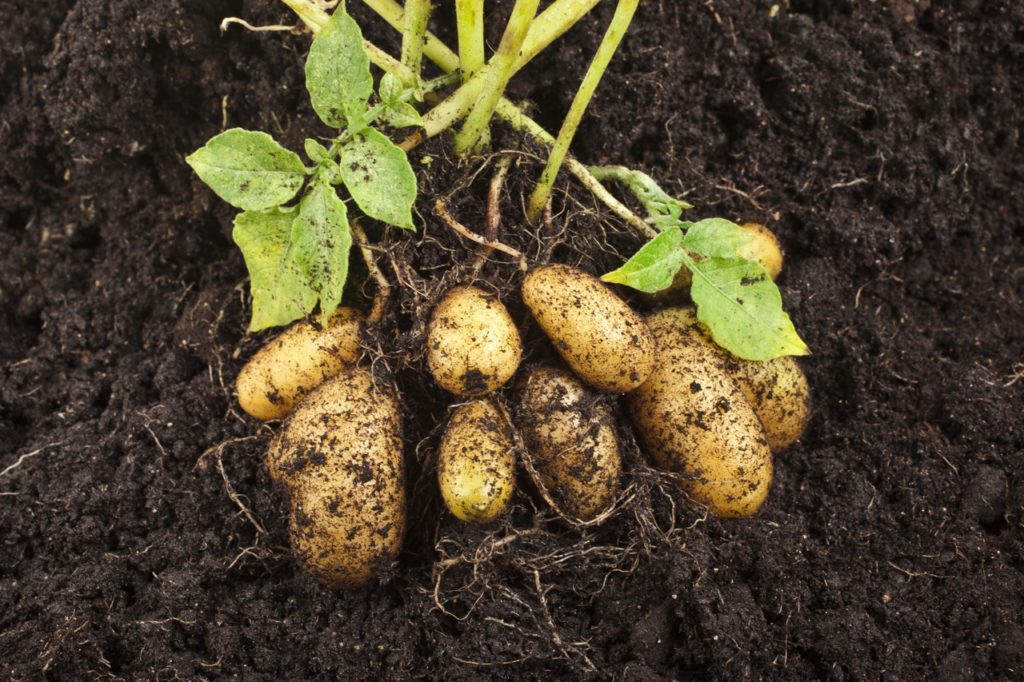
For a starchy tuber that seems such an intrinsic part of the typical British diet, it may surprise you to learn that potatoes were only introduced to Europe in the latter half of the 16th century, and only after the 1750s did they become a common agricultural crop.1Ortiz, D. (2022, February 25). How the humble potato changed the world. BBC Travel. Retrieved March 22, 2023, from https://www.bbc.com/travel/article/20200302-the-true-origins-of-the-humble-potato
Today, of course, potatoes are a staple of our homegrown diets and we can choose from a wide range of varieties to suit our different growing conditions and meet our different needs and wishes.
Common Types
There are three main types of potato, grouped according to the stage at which they are typically harvested: first earlies, second earlies and maincrop potatoes.
Within these groups, there are of course numerous varieties to choose from.
| Type | Common Varieties | When To Plant | When To Harvest |
|---|---|---|---|
| First Early | Maris Bard, Swift, Foremost | Late March | June to July |
| Second Early | Kestrel, Nadine, Charlotte | Early to Mid April | July to August |
| Maincrop | Maris Piper, Desire, Sarpo Mira | Mid to Late April | August to October |
When To Grow Potatoes
Potatoes are typically planted in the spring, between March and May, but they can also be planted in summer for Christmas harvests.
When precisely you will plant your seed potatoes depends on where you live and what the conditions are like there.
The more northern or upland your location in the UK, the later you are likely to plant.
The precise timing will also depend on which type and variety you have chosen to grow.
“I can sow first early potatoes in late February on a south-facing slope in the southwest of the UK,” says Master Horticulturist Colin Skelly.
“By the time the foliage emerges the risk of frost is diminishing. Harvesting can be begun in June.
“In more northern or north-facing areas, delaying sowing into late March or early April would be recommended to avoid frost damage of emergent foliage.”
Chitting Potatoes
Before you plant your seed potatoes, it is a good idea to chit them.
Chitting potatoes is the name given to the process of leaving the seed potatoes in a bright, cool area to form green shoots.
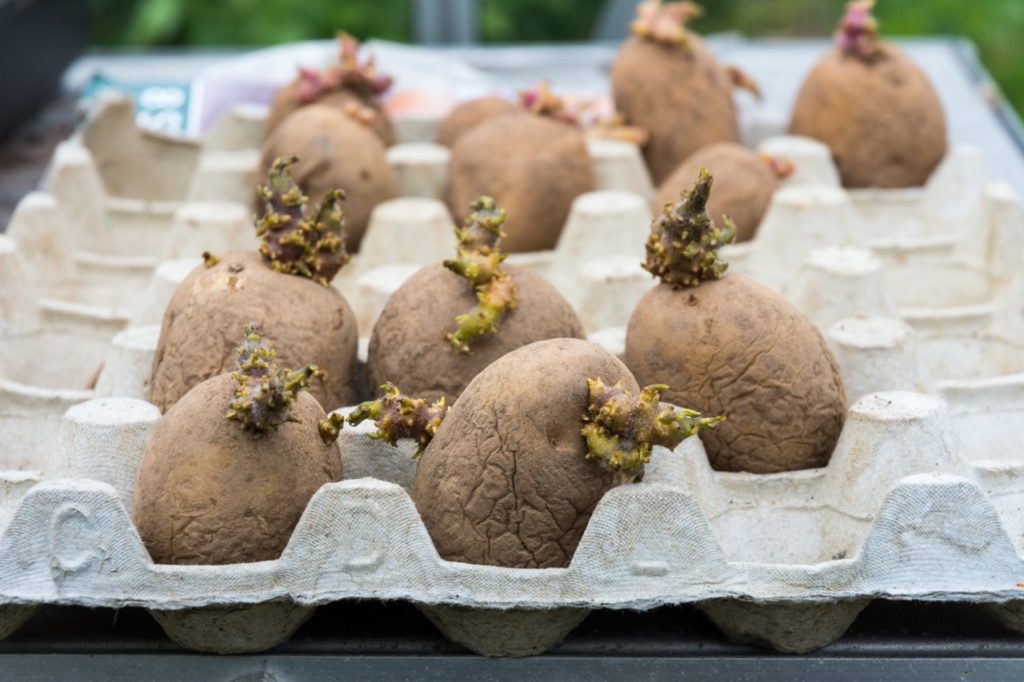
The idea is that getting potatoes to sprout before you plant them gets them off to a good start and could mean an earlier harvest.
To chit potatoes, around 6-8 weeks before you plan to plant your seed potatoes, place the potatoes with their eyes facing upwards in a bright but cool spot, such as a sunny windowsill inside your home or a porch.
Chitting is not essential and many commercial growers simply won’t bother, but I still believe that it is a good idea – especially for earlier plantings.
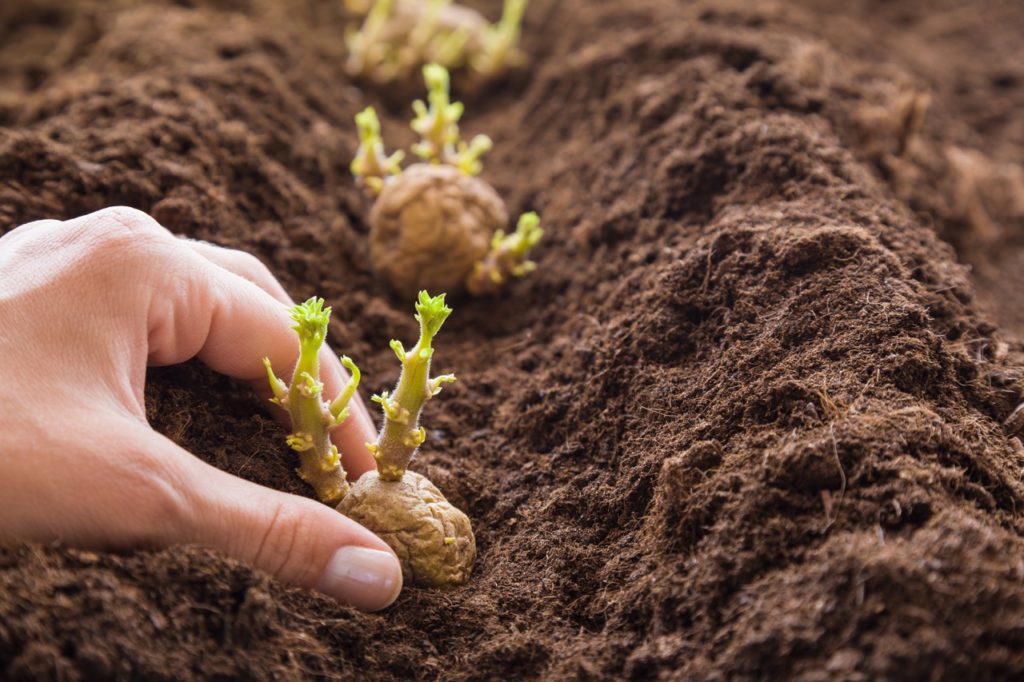
It won’t take much time or effort, so, unless you are growing on a massive scale, I would recommend it for home gardeners.
How To Plant Potatoes
The first step in planting seed potatoes is determining where you will grow your crop.
You might grow potatoes in a container of some kind, such as grow bags or pots.
Where space is limited, growing in a more innovative and space-saving way can be a good idea.

However, in this guide, we will focus on growing potatoes in the ground in your garden.
When planting potatoes, the process is pretty simple.
- Prepare your growing area.
- Place your tubers at a sensible width apart.
- Cover your tubers with soil or organic matter.
1) Preparing Your Growing Area
First of all, you need to make sure that your growing area is ready and suited to provide the conditions that your potatoes require.
The soil should be reasonably fertile, nutrient-rich and healthy, with plenty of organic matter.
It should ideally not be too compacted and should be aerated and moisture-retentive in order to achieve the best results and obtain the best yields.
When growing potatoes in the ground or in raised beds, you have two main options to consider – you can either grow traditionally in the soil or you can take a ‘no dig’ approach.

The latter is my own favoured approach and is the method I use in my own garden.
Traditional gardeners will usually prepare a growing area for potatoes by digging in organic matter, then making a trench in which to place the seed potatoes.
Typically, these trenches will be around 12cm deep and be spaced to create rows spaced around 65-75cm from one another.
In a no-dig garden, rather than digging in organic matter, we layer it on top of the soil – and rather than making a trench, we place potatoes on the soil surface, surrounded by layers of organic material.
2) Placing Tubers
Once you have created and prepared your growing areas, the next step is to simply place your tubers in their growing positions.
In a traditional garden, the potatoes are placed in the trench or trenches that have been created, sometimes on a bed of mulched material.
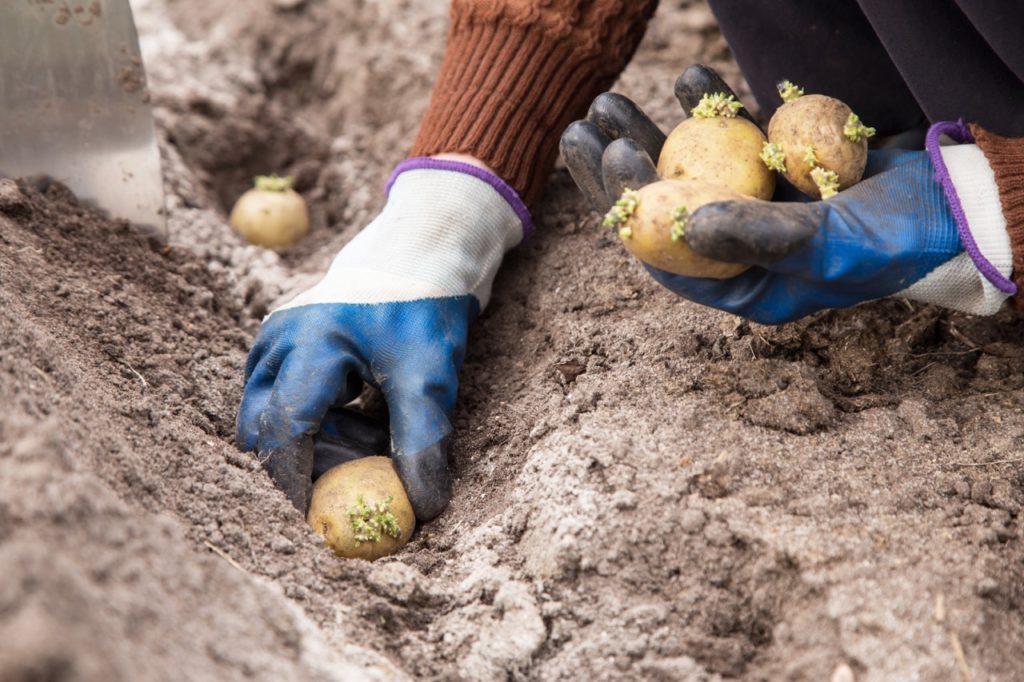
In a no-dig bed, the mulch is moved aside and potatoes are placed on the surface of the soil below.
However, in both cases, the spacing is more or less the same.
The tubers are placed around 35-40cm apart from one another, in rows that are around 65-75cm apart.
3) Cover Your Tubers
Once you have placed your tubers, it is time to cover them over.
In the traditional method, you will backfill your trench with the soil that was removed from it.
In the no-dig method, you will cover the potato tubers with layers of organic matter rather than soil.
There are numerous different materials that you can use.
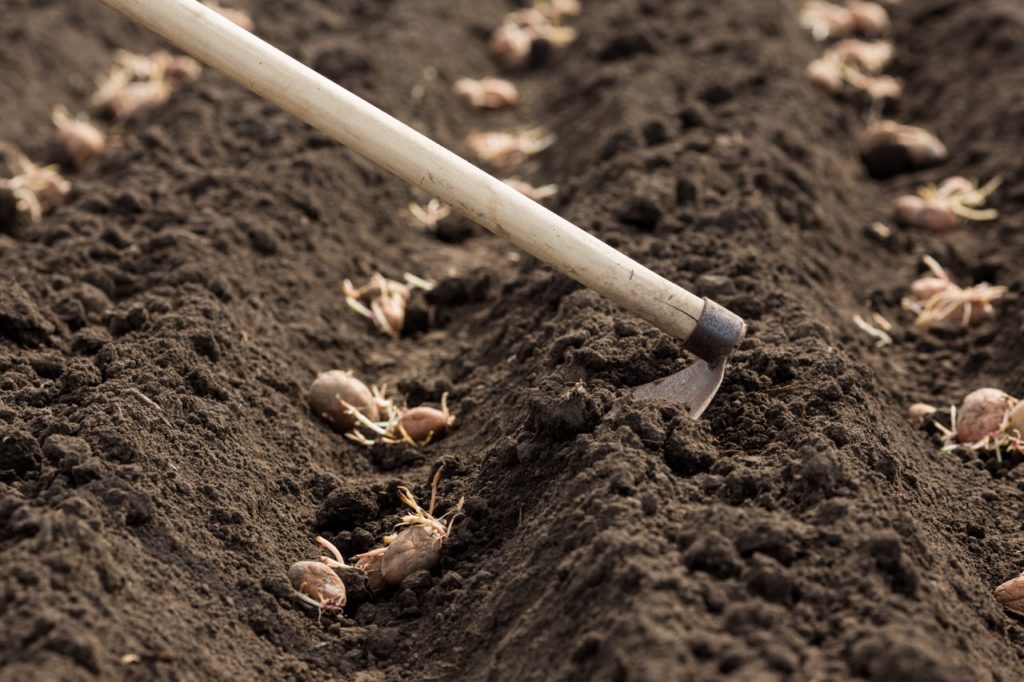
I like to use a range of different materials, such as clippings and leaves, dried leaves or leaf mould, and sometimes seaweed.
I then cover these layers with homemade compost.
Whichever method you use, it is important to make sure that the tubers are covered with a layer of soil or organic matter around 10cm thick.
After this, you should water the area well to ensure that there is enough moisture for the early stages of potato plant growth.
Potato Plant Care
Once you have planted your potatoes, it is essential to make sure that they have the right environmental conditions and care throughout the growing season.

Potatoes are not too challenging to grow in most UK gardens, but it is important to make sure that the fundamentals of soil, sunlight and water are in place.
Preferred Soil
Choosing the right location and preparing your growing area well is only part of the puzzle, as you also need to make sure that potatoes have the nutrients they need as they continue to grow, throughout the growing season.
This is why, whether you choose a traditional or a no-dig method, incorporating and adding plenty of organic matter is key.
Another important factor in growing potatoes is a process known as ‘earthing up’.
This simply involves covering up the lower portions of the stem of potato plants as they grow, which encourages more tubers to form.
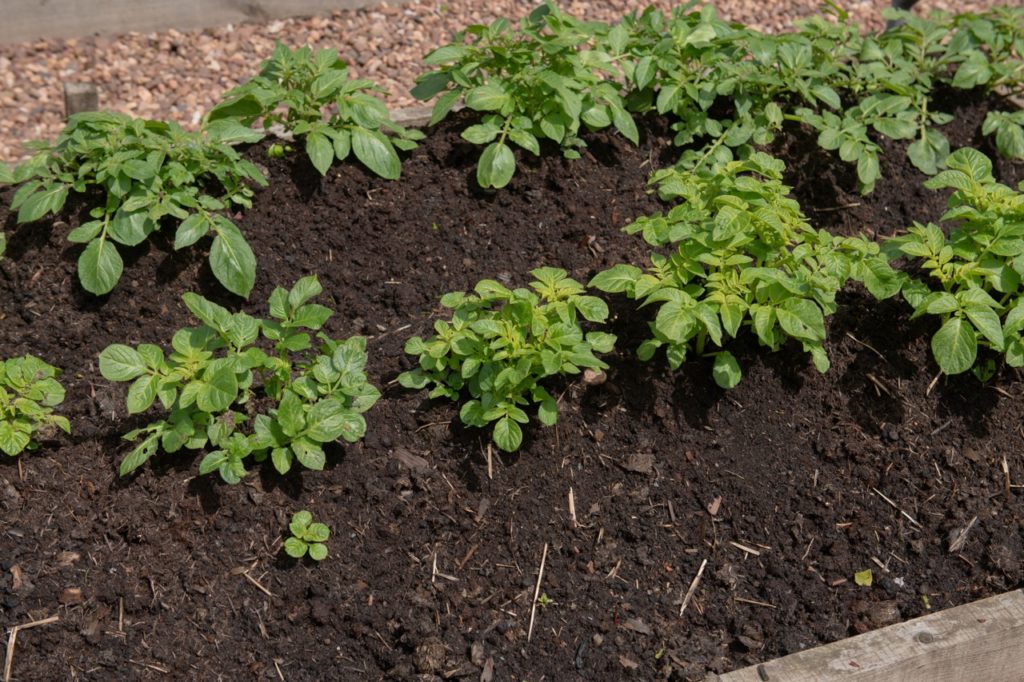
In traditional gardening, this means mounding soil around the base of the plant.
Typically, when the plant emerges from the soil and becomes around 20cm tall, the soil is drawn up around the plant to create a ridge around 15cm in height.
This process is then repeated a couple more times as the plants grow so that you end up with a ridge along your rows around 20-30cm tall.
In a no-dig garden, you also create mounds along our rows of potato plants, but rather than earthing up with soil, you should use organic materials.
This involves piling mulch and compost around the plants and continuing to add mulch as the potato plants grow over time.
Position & Sunlight
Potatoes should ideally be positioned in a position in full sun.
Potatoes can grow in shaded positions, but the yield will typically not be as high and plants may produce more leafy growth rather than focussing on tuber production.
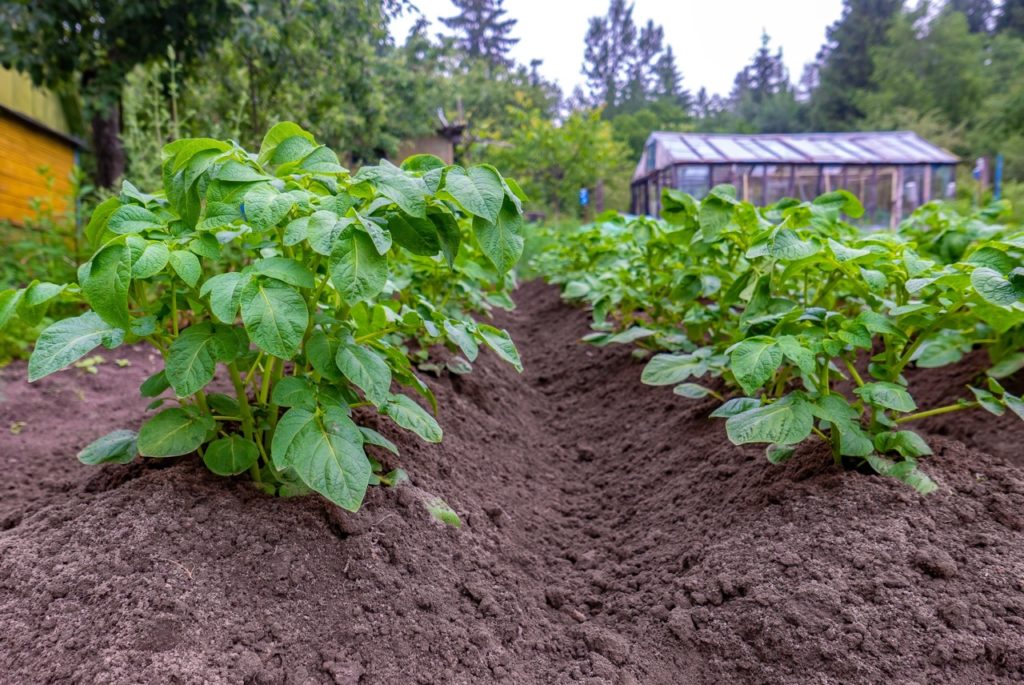
It is also important to consider how other crops may shade potatoes in your garden as they grow.
Think carefully about where the sun shines as it travels across the sky each day and throughout the year, and about the layout of your vegetable garden.
Watering & Feeding
Make sure that you give your potatoes a good drink after planting and then make sure that the medium remains moist throughout the summer growing season.
Harvesting
When you will harvest your potatoes depends on which type you are growing and the method depends on whether you have grown in a more traditional way or used the no-dig approach.

In a traditional garden, you will typically unearth the potatoes using a garden fork, taking care to avoid piercing or damaging the tubers.
In a no-dig garden, you can simply rake away the layers of mulch and compost to reveal the tubers below and pick out the potatoes by hand.
Common Problems
Unfortunately, potatoes can be prone to a range of diseases – the most worrying of which is late blight.
Other issues include potato blackleg, potato scab and potato rot.
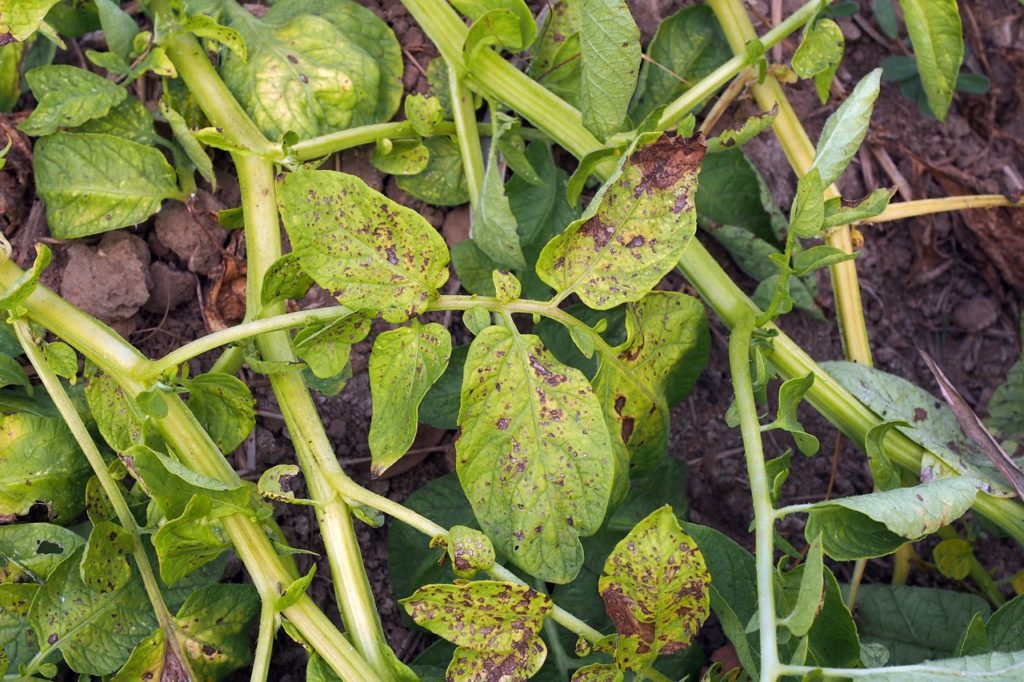
Unfortunately, these can often cause losses when the summer conditions are less than ideal.
If you frequently experience losses, choosing more resistant cultivars could be a good idea.
FAQs
Can You Plant Potatoes In The Same Place Twice?
You can, but it is not a good idea – this can cause build-up of pests and diseases in the soil.
Crop rotation is important when growing potatoes and you should be sure to put a 3-4 year crop rotation plan in place.
Which Way Up Should You Plant Potatoes?
Be sure to plant potato tubers with the sprout facing upwards.
How Many Potatoes Can You Typically Harvest Per Plant?
How many potatoes you can get from one seed potato very much depends on the variety you are growing and where you live.

However, you can typically expect to get between 5-15 potatoes per plant.
You can expect fewer if the potatoes are larger and more if they are on the smaller side as a variety.
Do Onions Make Suitable Potato Companion Plants?
Onions can be beneficial when intercropped with potatoes or placed around the edges of a bed, as they may help to repel certain pests that plague young potato plants.
However, remember that onions have shallow roots and the earthing-up process may disturb them, so they might not always be the best option for a potato companion plant if they are bulbing types.

Try bunching onions, green onions or spring onions around the edge of a bed instead.
However, I don’t tend to choose onions for potato plant companions.
Instead, I like to plant with early peas or broad beans for nitrogen fixation, radishes around the edge of the bed and borage to pop up here and there through the bed.
I tend to intercrop onions with carrots and other root crops.
References
- 1Ortiz, D. (2022, February 25). How the humble potato changed the world. BBC Travel. Retrieved March 22, 2023, from https://www.bbc.com/travel/article/20200302-the-true-origins-of-the-humble-potato

